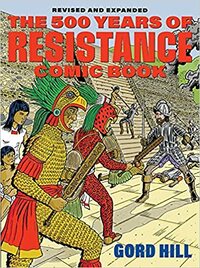You need to sign in or sign up before continuing.
Take a photo of a barcode or cover
44 reviews for:
The 500 Years of Indigenous Resistance Comic Book: Revised and Expanded
Gord Hill, Pamela Palmater
44 reviews for:
The 500 Years of Indigenous Resistance Comic Book: Revised and Expanded
Gord Hill, Pamela Palmater
dark
informative
reflective
sad
fast-paced
Graphic: Violence, Police brutality, Colonisation, War
informative
fast-paced
dark
informative
reflective
sad
fast-paced
informative
inspiring
fast-paced
Graphic: Violence, War
The 500 Years of Indigenous Resistance Comic Book is a brilliant intro to the hundreds of years (from 1492 to present) of the history of Indigenous people in the Americas resisting colonial invasion, occupation, and violence. It covers a wide geographic space and a fairly lengthy amount of time in a relatively short space, but it makes well use of that space. This book is filled with information that every person has the right to know but is all too often avoided in our schools. Highly recommended.
A heavy read, even in graphic novel form, but the format worked and helped me get through content I wouldn’t have managed if it was straight text. Of course it was filled with history I didn’t know, definitely a history book with illustrations and not a graphic novel with history in it.
I skimmed this book. I think it's a good resource. I think it accurately tells a very violent history of colonization. I think my favorite part is we made it all the way up to current history. I for sure thought it would stop at AIM but it covered #NoDAPL too.
challenging
informative
medium-paced
A rousing call to action in the fight for Indigenous sovereignty, land repatriation, and reparations. Damning evidence presented against colonial forces in the Americas from 1492 to present.
Felt evenly balanced between the continents and under different colonial occupations ("USA", "Mexico", "Canada", "Peru" for example).
Highly recommend for home, classroom, and public libraries. Undoing the harm perpetuated by manipulative, biased, and purely untrue history lessons and contemporary media reports on these ongoing genocides.
Felt evenly balanced between the continents and under different colonial occupations ("USA", "Mexico", "Canada", "Peru" for example).
Highly recommend for home, classroom, and public libraries. Undoing the harm perpetuated by manipulative, biased, and purely untrue history lessons and contemporary media reports on these ongoing genocides.
challenging
informative
slow-paced
If you have read the original of this comic published in 2010, I would recommend picking this up as well. This updated version expands on details in the original with completely new art, writing, and content.
Compared to the 2010 version- should you read both?
The 2021 book draws on content from the 2010 book but both have their strengths. The 2021 is more polished and detailed overall, but the 2010 version includes some content that this new version doesn't touch on.
Most notably, the 2021 version lacks a preface from Gord Hill. I liked Pamela Palmeter's foreword but it is a huge loss to completely remove the two pages written by Hill in the original. Hill's preface introduced readers to Hill and acted as an artist statement that was, in my opinion, a much more meaningful way to preface the comic than only a foreword from an outside person.
In terms of art, the 2021 art is more sophisticated and simplistic to accommodate full-colour. The colouring is a HUGE addition as it really allows Hill to celebrate the different cultures of each People more than the black and white could. Still, I would encourage readers to check out the 2010 version as the art has a bit more personality in my opinion - really distinct heavy line work and shading that had to be sacrificed for the colour.
Review
This is a thorough, but high-level overview of a select number of instances of Indigenous resistance across the Americas between the 1400s and present. The book covers a variety of Peoples across the Americas but obviously cannot cover every unique People or instance of resistance so I would recommend consuming other Indigenous-authored content as well. Notably, the comic is missing content on any Métis or Inuit peoples (see end for some recommendations that can help supplement this).
While the text is written in plain language and the comic-format can help with engagement, this is an incredibly dense book. There are lots of descriptions of events with dates, specific people, the amount of deaths, etc. so it can be hard to follow at times and you might need to read it in chunks. It becomes easier once you are used to the style and the events in the 1900s-present have simpler details.
The art is distinct but can be simplistic. The simple art works well with the straight-forward, educational presentation of the content and there are some interesting ways certain panels interact with each other.
Who should read?
I would recommend this to anyone - particularly if you are educated on the general history of colonization but not on Indigenous resistance or if you have a good understanding of Indigenous history in North America but not Central or South America. When learning about colonization, it's important to not only learn about the historical and ongoing injustices but to also acknowledge past and present Indigenous resilience. This is a good starting resource for both. This comic provides a basic background on colonization but it celebrates Indigenous resistance and resilience first-and-foremost, so you will need to consult other resources for a more thorough understanding. Similarly, it provides a good starting point for some key events in the history of Indigenous resistance but I'd highly recommend taking your reading further if you the comic content interested you.
Recommendations for further reading
To start filling the Métis and Inuit gap I can recommend the Pemmican Wars comic series which is about a young Métis girl and Angry Inuk which is a film that highlights some Inuit resistance in the face of anti-sealing activists.
If you enjoyed the more modern resistance efforts, you might also enjoy The Road Forward which looks at First Nations resistance in BC and celebrates Indigenous resilience through art - free on NFB's YouTube channel (there are so many other films free on NFB and CBC Gem too, and resources online with more book and comic recommendations). There is also a free film on NFB titled Kanehsatake: 270 Years of Resistance which covers the Oka Crisis in more detail than the comic.
For general resources (biased to "Canada") this Google Doc is a list of online educational resources, books, and films: https://rb.gy/5hsmix
Compared to the 2010 version- should you read both?
Most notably, the 2021 version lacks a preface from Gord Hill. I liked Pamela Palmeter's foreword but it is a huge loss to completely remove the two pages written by Hill in the original. Hill's preface introduced readers to Hill and acted as an artist statement that was, in my opinion, a much more meaningful way to preface the comic than only a foreword from an outside person.
In terms of art, the 2021 art is more sophisticated and simplistic to accommodate full-colour. The colouring is a HUGE addition as it really allows Hill to celebrate the different cultures of each People more than the black and white could. Still, I would encourage readers to check out the 2010 version as the art has a bit more personality in my opinion - really distinct heavy line work and shading that had to be sacrificed for the colour.
Review
This is a thorough, but high-level overview of a select number of instances of Indigenous resistance across the Americas between the 1400s and present. The book covers a variety of Peoples across the Americas but obviously cannot cover every unique People or instance of resistance so I would recommend consuming other Indigenous-authored content as well. Notably, the comic is missing content on any Métis or Inuit peoples (see end for some recommendations that can help supplement this).
While the text is written in plain language and the comic-format can help with engagement, this is an incredibly dense book. There are lots of descriptions of events with dates, specific people, the amount of deaths, etc. so it can be hard to follow at times and you might need to read it in chunks. It becomes easier once you are used to the style and the events in the 1900s-present have simpler details.
The art is distinct but can be simplistic. The simple art works well with the straight-forward, educational presentation of the content and there are some interesting ways certain panels interact with each other.
Who should read?
I would recommend this to anyone - particularly if you are educated on the general history of colonization but not on Indigenous resistance or if you have a good understanding of Indigenous history in North America but not Central or South America. When learning about colonization, it's important to not only learn about the historical and ongoing injustices but to also acknowledge past and present Indigenous resilience. This is a good starting resource for both. This comic provides a basic background on colonization but it celebrates Indigenous resistance and resilience first-and-foremost, so you will need to consult other resources for a more thorough understanding. Similarly, it provides a good starting point for some key events in the history of Indigenous resistance but I'd highly recommend taking your reading further if you the comic content interested you.
Recommendations for further reading
To start filling the Métis and Inuit gap I can recommend the Pemmican Wars comic series which is about a young Métis girl and Angry Inuk which is a film that highlights some Inuit resistance in the face of anti-sealing activists.
If you enjoyed the more modern resistance efforts, you might also enjoy The Road Forward which looks at First Nations resistance in BC and celebrates Indigenous resilience through art - free on NFB's YouTube channel (there are so many other films free on NFB and CBC Gem too, and resources online with more book and comic recommendations). There is also a free film on NFB titled Kanehsatake: 270 Years of Resistance which covers the Oka Crisis in more detail than the comic.
For general resources (biased to "Canada") this Google Doc is a list of online educational resources, books, and films: https://rb.gy/5hsmix
Graphic: Violence, Police brutality, Colonisation
Minor: Rape, Slavery








